The conference was attended by Mr. Nguyen Van Nen – Member of the Politburo, Secretary of the Ho Chi Minh City Party Committee, and representatives of departments, branches, and localities in the Southeast region.
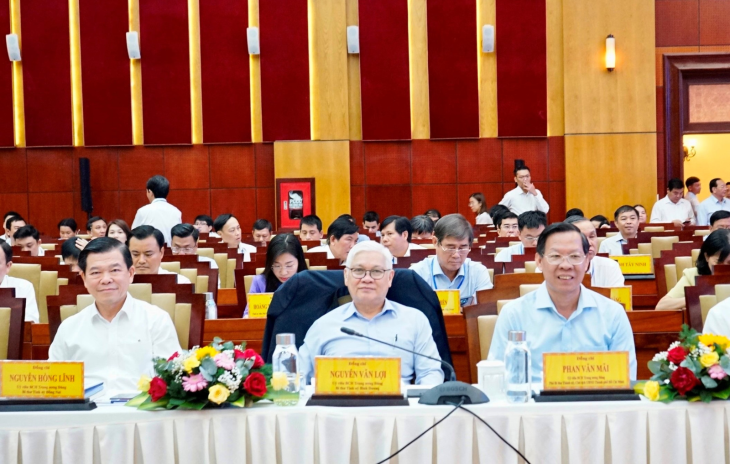
Leaders of provinces and cities attended the conference
On the side of Binh Duong province, there were Mr. Nguyen Van Loi – Member of the Party Central Committee, Secretary of the Provincial Party Committee, Head of the Provincial National Assembly Delegation; Mr. Vo Van Minh – Deputy Secretary of the Provincial Party Committee, Chairman of the Provincial People's Committee (PPC); representatives of provincial departments and branches.
Building the Southeast region with modern and synchronous infrastructure
The conference announced the Southeast Regional Plan for the term 2021-2030, with a vision to 2050.
Accordingly, the scope of planning boundaries includes the entire administrative boundary of Ho Chi Minh City and 5 provinces, i.e., Dong Nai, Binh Duong, Ba Ria – Vung Tau, Binh Phuoc, and Tay Ninh.
The planning goal is that by 2030, the Southeast region will become a civilized, modern, industrial-developed region, surpassing the threshold of high income, material and spiritual life of the leading people nationwide; will be the largest growth-driving area in the country, developing dynamically and with a high growth rate; Science, technology, and innovation centers, high-tech industries, logistics, and international financial centers will be highly competitive in the region.
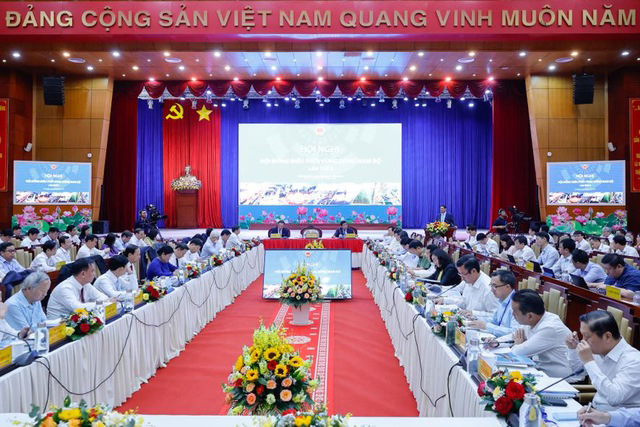
Overview of the conference
Regarding the economy, the region is striving for the average GRDP growth rate from 2021 to 2030 to reach about 8-9% per year. GRDP per capita at current prices is about 380 - 420 million VND, equivalent to 14,500 - 16,000 USD.
The proportion of service sector accounts for about 41-42% of GRDP; industry and construction are 45-46% (in particular, processing and manufacturing industry are about 33%); agriculture, forestry, and fishery account for 2-3%; Product tax minus subsidies account for 10 - 11%.
Socially, the Human Development Index (HDI) is above 0.8. The proportion of trained workers with certificates reaches about 40-45%; the unemployment rate remains below 3%, and so on.
The growth rate of GRDP in the term 2031-2050 will reach about 7.5%/year, and GRDP/person by 2050 will reach about 54,000 USD.
The Southeast will accelerate regional economic restructuring in association with renovating growth models, creating breakthroughs to improve productivity based on science, technology, innovation, and digital transformation. It will develop a number of modern industries and services to become new growth engines such as the semiconductor industry, chip manufacturing, financial services (associated with the formation of an international financial center), and logistics.
It will also form a synchronous, modern, and smart infrastructure framework, focusing on transport, urban, energy, digital, social, and irrigation infrastructure, preventing and controlling natural disasters, and adapting to climate change. Besides, it will fundamentally solve traffic congestion, waterlogging, and environmental pollution. The region will promote urban development in association with the development orientation of transit-oriented development (TOD).
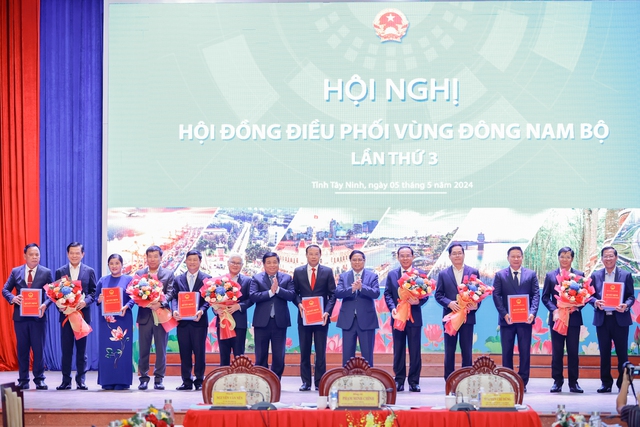
Prime Minster Pham Minh Chinh handed over the Decision approving the master plan to localities.
The region will focus on developing the Southern Dynamic Region (National Dynamic Zone) to become the leading economic center of the country and Southeast Asia. Urban construction in Ho Chi Minh City will be built to be modern, intelligent, leading and creating spillover effects, linking urban areas, being competitive, integrating regionally and internationally, and playing an important role in the urban network of the region.
It will form and develop economic corridors, with priority given to the North-South economic corridor, Moc Bai – Ho Chi Minh City - Bien Hoa - Vung Tau economic corridors, and the industrial - urban - service belts associated with Ring Road 3, Ring Road 4 of Ho Chi Minh City; effectively connecting seaports, airports, international border gates, major trade hubs, cities, economic centers and serving as a basis for reorganizing the regional development space.
The plan is also to strengthen intra-regional and inter-regional linkages to ensure efficient use of resources and improve regional competitiveness...
According to the report of the People's Committee of Binh Duong province, the Ministry of Planning and Investment has chaired the organization of the conference on the appraisal of the planning of Binh Duong province in the term 2021 - 2030, with a vision to 2050. Thereby, the Appraisal Council has made comments, assessed the conformity, and compliance with the planning submission, integrated contents, diagram system, maps, etc., and other comments contributed by reviewers to ensure that they are consistent with the general development orientation of the region and the country.
It is expected that the planning of Binh Duong province in the term 2021 - 2030 will be approved by the Provincial People's Council in 5/2024 and submitted to the Prime Minister in June 2024.
The planning of Binh Duong province in the period of 2021 - 2030, vision to 2050 is a framework for the strategic orientation of development, in order to renew thinking and vision, promoting the dynamism and creativity of local authorities and the companionship and guidance of leading enterprises to create new impetus for the strong transformation of existing models to new development models, from the township symbiotic and service-integrated industrial model to the modern industrial model adapting to the Industrial Revolution 4.0: High-tech industry (participating in global supply and value chains) - smart and innovative cities (modern and livable cities) - high-quality services (participating in value chains inflated).
Proposing mechanisms and policies for the implementation of the Ring Road 4
At the conference, representatives of ministries, branches, and localities discussed and proposed mechanisms and policies for the development of the Southeast region, especially for key transport projects with regional connectivity.
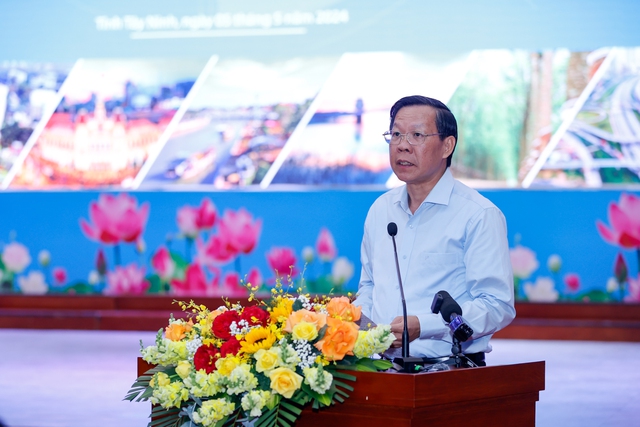
Chairman of Ho Chi Minh City People's Committee Phan Van Mai proposed mechanisms and policies for localities in the Southeast region
According to Mr. Phan Van Mai - Chairman of Ho Chi Minh City People's Committee, the Ring Road 4 project is being actively implemented by localities in the region. However, the current difficulty is the lack of mechanisms for localities to use local budget capital to invest in the Ring Road 4 project, the capital for the project implementation is large but the local budget is limited, etc. Therefore, Ho Chi Minh City proposed that the Prime Minister approve the policy of assigning the Ho Chi Minh City People's Committee to coordinate with ministries, branches, and localities to develop specific policies applicable to the construction projects of Ring Road 4 in Ho Chi Minh City. The central budget supports Binh Duong, Dong Nai, and Ba Ria – Vung Tau with 50% of the cost of site clearance compensation of about 10,041 billion VND; of which Binh Duong is about 4,398 billion VND, Ba Ria – Vung Tau is 1,718 billion VND, Dong Nai is about 3,925 billion VND. Particularly, Long An province proposed to support 75% of the total budget capital participating in the project, equivalent to about 28,458 billion VND.
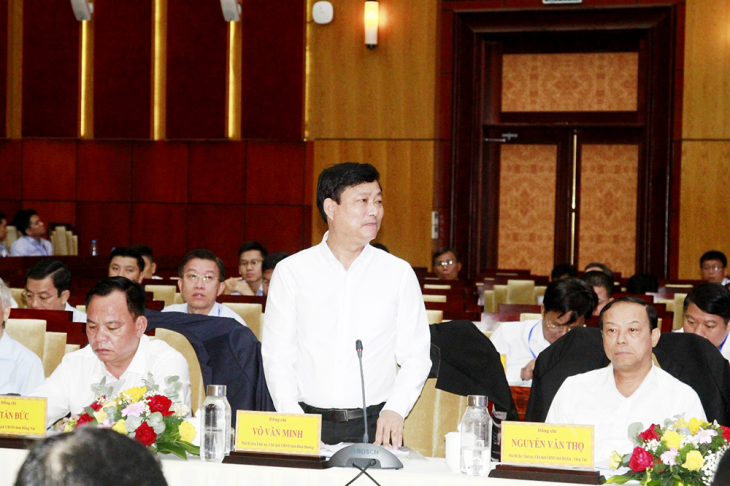
Chairman of Binh Duong People's Committee Vo Van Minh gave a speech at the conference
In consensus with the proposal and recommendations of Ho Chi Minh City, Mr. Vo Van Minh – Chairman of Binh Duong People's Committee said that after more than one year of implementing Resolution No. 24-NQ/TW of the Politburo, the province has many remarkable achievements, including Development cooperation with localities in the Region to remove difficulties, problems for key traffic projects such as Ring Road 3, Ring Road 4, Ho Chi Minh City - Chon Thanh Expressway, etc., determine the route directions connecting localities in the Region to airports (Tan Son Nhat, Long Thanh), seaports (Cai Mep - Thi Vai); have an investment plan to develop Song Than station (Di An) into a key freight transportation center of the Southeast region, from which goods transported by rail from Binh Duong will connect with provinces and cities from the South to the North.
However, the province is facing difficulties in the implementation of the Ring Road 4 project in Ho Chi Minh City which passes through Binh Duong province due to difficulties in provincial budget capital and huge investment demand in the province. Therefore, the province proposes central agencies to consider supporting 50% of the total budget capital participating in the project for the road through Binh Duong province similar to the Ring Road 3 project in Ho Chi Minh City.
In addition, the Thu Bien bridge construction project is not on the list of pilot projects with some specific policies on investment in road construction. Therefore, the province proposes central agencies consider and approve Binh Duong province to apply the mechanism: "The provincial People's Council is entitled to decide to use the local budget and approve investment policies for the implementation of traffic projects and works of regional and inter-regional located on the boundary, administrative boundaries between localities under the Ring Road 4 project in Ho Chi Minh City" to have a foundation to continue implementing the project.
Through reviewing the draft report on specific mechanisms and policies for the Southeast region, Chairman of the Provincial People's Committee Vo Van Minh proposed that the Ministry of Planning and Investment soon complete and submit to the National Assembly for promulgation to remove difficulties and obstacles in institutions and create a breakthrough growth engine for provinces, cities in the Region.
Regarding investment resources, according to Mr. Vo Van Minh, regional transport infrastructure needs large resources whilst the Southeast region has 4/6 provinces and cities in the group of localities that have budget regulation to the Central. However, on average, the proportion of the local budget received is lower than in other regions. Therefore, the province also proposed ministries, branches, and central agencies to adopt policies and mechanisms to remove difficulties, and to increase the rate of regulation of local budget sources accepted so that provinces and cities in the region concentrate resources on synchronous investment in inter-provincial transport infrastructure, and regional infrastructure.
Through the discussion of ministries, branches, and localities, the concluding remark, Prime Minister Pham Minh Chinh praised the achievements in the socio-economic development of localities in the Southeast region. The Prime Minister also pointed out limitations that are not commensurate with the development of the region such as the development of the cultural industry; the connectivity infrastructure between regions is still limited in transport, supply chain, and production of goods; environmental pollution, flooding, and traffic jams still take place; the support between localities is still limited, especially budget support, etc.
Therefore, the Prime Minister proposed that localities in the Southeast region need to "accelerate, breakthrough, pioneer, resolute, rigorous, quality and effective". In particular, it is necessary to develop mechanisms and policies for ventilation and innovation; building strategic infrastructure must be fast and modern; management must be smart, in line with new development trends. Besides, it goes hand in hand with innovation, scientific and technological development, consumer export investment, adding new motivation; building a green, circular, and knowledge-based economy; and identifying 03 strategic breakthroughs: Infrastructure, institutional, and human development.
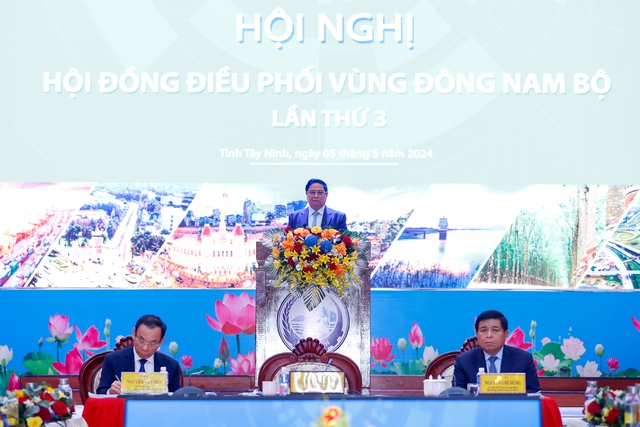
Prime Minister Pham Minh Chinh gave a speech after the conference
The Prime Minister emphasized the key tasks for the development of the Southeast region in the coming time. In particular, people must be put at the center of development; focus on developing synchronous and modern transport infrastructure; and mobilize all resources for development, especially capital resources.
The Prime Minister agrees with localities' proposals in developing mechanisms and policies for implementing the Ring Road 4. The Ministry of Finance is responsible for studying and proposing regimes and policies to mobilize capital sources for project implementation. The Prime Minister proposed to complete Long Thanh Airport in 2025; the expansion project of Tan Son Nhat Airport must be completed by April 30, 2025; to accelerate the deployment of expressways, especially the Bien Hoa – Vung Tau expressway. The Government Office synthesizes local proposals to assign leaders of the Government and ministries to coordinate in implementing specific tasks.